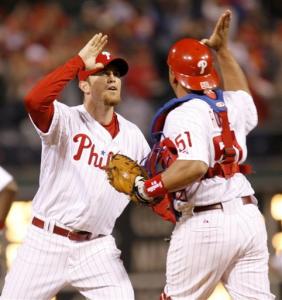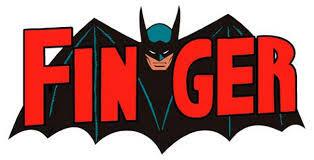 After a spate of surprising moves made by the Phillies this week, one has to wonder if there is more coming. Could a big trade be looming on the horizon? With the team in first place in the National League East and the team’s brass on the record indicating that they would like to bolster its pitching staff, it’s a fair assumption.
That assumption is greatly enhanced by the developments this week.
After a spate of surprising moves made by the Phillies this week, one has to wonder if there is more coming. Could a big trade be looming on the horizon? With the team in first place in the National League East and the team’s brass on the record indicating that they would like to bolster its pitching staff, it’s a fair assumption.
That assumption is greatly enhanced by the developments this week.
It started on Tuesday when the club announced that it had coaxed maligned Opening Day starting pitcher Brett Myers to accept an option to Triple-A Lehigh Valley in order to iron out his difficulties on and off the mound. A season removed from working as the team’s closer, Myers struggled with the transition back to a starting role in 2008. In 17 big-league outings, Myers was 3-9 with a 5.84 ERA and had allowed a Major League-leading 24 home runs.
Upon accepting the… ahem… mental rehab trip to the minors, Myers told The Philadelphia Inquirer that he preferred pitching out of the bullpen and saw a future as a big-league closer.
“I want to be great, and honestly, I realized last year that I'd only be a good starter,” Myers told the Inquirer. “I felt like I had rock-star status as a closer. I enjoyed the bullpen. I felt like they liked me in that role. But it was easier to get a closer than another starter. (Closer Brad) Lidge has done a hell of a job for us. I don't think I could do better.”
Based on the developments on Sunday morning, the Phillies don’t think Myers could (or can) do better, either. As a result, general manager Pat Gillick announced that the club had agreed to a three-year contract extension with Brad Lidge worth $37.5 million. The deal lasts through the 2011 season with a club option for 2012 plus a few performance incentives and bonuses thrown in.
So if Myers is going to pitch for the Phillies in the future, it won’t be as the team’s closer. Yet then again, the Phillies did sign Myers to a three-year deal worth $25.75 million before last season to be a starter.
Clearly, the Phillies were serious about that.
“People have drawn the conclusion that he would rather close, and that may be the case, but let me put it this way: There's a lot of things in life that a lot of people don't want to do. But you're getting paid, and you've got to show up for work and do the best job you can,” Gillick told reporters on Sunday morning. “He's a gamer, and I think he'll give 100 percent whether he's in a closer situation or as a starter.”
Frankly, Gillick and the Phillies need Myers to start.
“We're kind of stubborn. We think that Brett can start,” Gillick said. “We don't see reason he can't start. If he gets his mechanical issues straightened out down there, I don't see any reason he can't be in our starting rotation.”
Myers began his minor-league stint last Wednesday in Allentown for Triple-A Lehigh Valley where he allowed three runs and five hits with six strikeouts in five innings against the Yankees top Triple-A club, Scranton/Wilkes-Barre. The big right-hander will make his second start in Allentown on Monday against Louisville and Reds’ top pitching prospect, Homer Bailey. But whether Myers will be elbowed out of the Phillies’ starting rotation appears to be up in the air, too. Of course if Myers irons out his trouble, which Major League and Minor League coaches say is mechanical and mental, then, yes, the Phillies will have a spot for him.
However, all indications are that the team will had another arm to the rotation. Rumors abound, of course, with names like starters C.C. Sabathia, Erik Bedard, A.J. Burnett, Jarrod Washburn, Greg Maddux, Bronson Arroyo and Randy Wolf, as well as reliever Brian Fuentes linked to a potential trade with the Phillies. Moreover, advance scouts from the Twins (Dennys Reyes? Livan Hernandez?) and Mariners have been watching the Phillies closely during the past week.
Yes, the future will be interesting for the Phillies.
While Myers’ place in the Phillies future is the great unknown, Lidge, 31, the closer acquired from Houston for Geoff Geary, Mike Costanzo and Michael Bourn last winter, isn’t going anywhere anytime soon.
Though he could have tested a very lucrative free-agent market this winter, Lidge figured that all things being equal, he’d rather be in Philadelphia.
“Coming into the year, I knew that this was my free-agent year, but pretty early on, I started really enjoying everything here,” Lidge said. “I understand what [free agency] could be like, but for me, this is an easy decision. I'm enjoying everything so much here. I don't know where I could go that would have a team with a better opportunity to get to the World Series, to win a World Series. For me, that's the most important thing, so where better than Philadelphia.”
The Phillies appear to have gotten a relative bargain with Lidge, too. During the past three winters, Billy Wagner signed a four-year, $43 million contract with the Mets; B.J. Ryan signed a five-year, $47 million deal with the Blue Jays; and Francisco Cordero signed a four-year, $46 million contract with Texas last winter.
Based on Lidge’s statistics so far (19 saves in 19 chances, an 0.77 ERA in 35 games and 47 strikeouts in 35 innings) he could have earned a fatter paycheck if he played the market.
The Phillies, obviously, went going to let it come to that.
“Right out of the chute, when we made the trade, we knew this wasn't going to be a one-and-done type of guy,” assistant general manager Ruben Amaro Jr. said in announcing the deal on Sunday morning. “We view Brad as somebody who can help us contend for many years. We all know how important it is to close out games you should win. This is an important piece to our organization's future.”
Interestingly, Lidge has thrived in Philadelphia after a rough ending to his time in Houston. Between a few injuries and a crushing home run allowed to Albert Pujols during the 2005 NLCS, Lidge struggled with effectiveness and his confidence in his last year with the Astros. But during the second half of the 2007 season, Lidge regained what was missing and has reestablished himself as one of the best closers in the Majors.
The fact that some hitters say his slider is the nastiest pitch in the game certainly helps, too.
Nevertheless, Lidge has found himself with the Phillies.
“I think if you're closing and you're going through a rough time, it's difficult no matter where you're at,” the newly named All-Star said. “I was really excited for this challenge. For whatever reason, coming in here, I felt like this was where I needed to be. I enjoy the fact that the fans here are so passionate about the game. That gives me a lot of energy. I love it here.”
And Philadelphia loves him back... so far.
Next, is a deal for Pat Burrell in the works?
Stay tuned.
Coming up: The team that loved Tom Gordon and even more from the Olympic Trials.


 Suddenly - just like that - it appears as if the Phillies have a pretty good-looking bullpen.
Now, if only they could get a No. 2 starter and slide Brett Myers back into an eighth inning role for new closer Brad Lidge...
Suddenly - just like that - it appears as if the Phillies have a pretty good-looking bullpen.
Now, if only they could get a No. 2 starter and slide Brett Myers back into an eighth inning role for new closer Brad Lidge... Given a choice, the Phillies and Brett Myers would have preferred to keep the team's 2007 Opening Day starter at the back end of the bullpen. It was there, all parties reasoned, that the big right-hander showed the most promise, and, more importantly, the most consistency.
That's not to say Myers isn't a good starting pitcher. Au contraire. One does not become the 12th player taken in the draft, get a call to the big leagues at age 21 and earn an Opening Day starting nod a few years before hitting free agency (had one not decided to sign a multi-year deal) by being bad. That's not how it works in the Major Leagues.
Given a choice, the Phillies and Brett Myers would have preferred to keep the team's 2007 Opening Day starter at the back end of the bullpen. It was there, all parties reasoned, that the big right-hander showed the most promise, and, more importantly, the most consistency.
That's not to say Myers isn't a good starting pitcher. Au contraire. One does not become the 12th player taken in the draft, get a call to the big leagues at age 21 and earn an Opening Day starting nod a few years before hitting free agency (had one not decided to sign a multi-year deal) by being bad. That's not how it works in the Major Leagues. "I definitely like closing more," Myers said. "I like having the ball in my hands four of five days. The only thing I don't like in starting is I may go nuts those four days in between getting the ball."
"I definitely like closing more," Myers said. "I like having the ball in my hands four of five days. The only thing I don't like in starting is I may go nuts those four days in between getting the ball." Brad Lidge knows his role, too, and he's very pleased about joining the Phillies to perform it. Lidge, it appears, is excited about getting the ever-popular "change of scenery" after spending the first six years of his career in Houston.
Brad Lidge knows his role, too, and he's very pleased about joining the Phillies to perform it. Lidge, it appears, is excited about getting the ever-popular "change of scenery" after spending the first six years of his career in Houston.